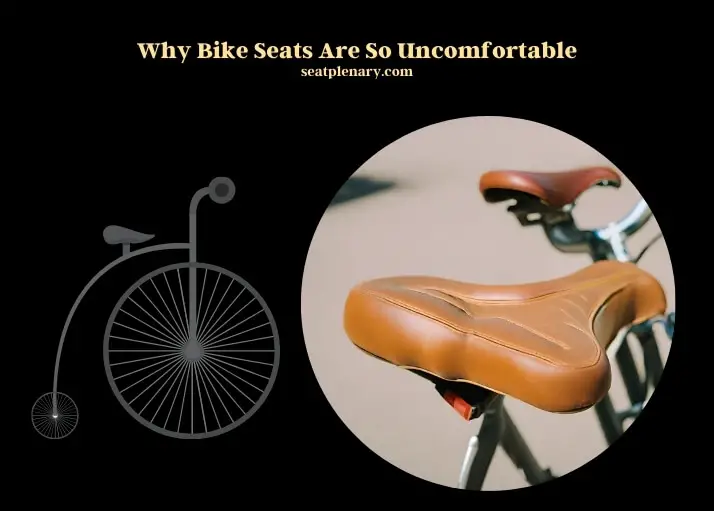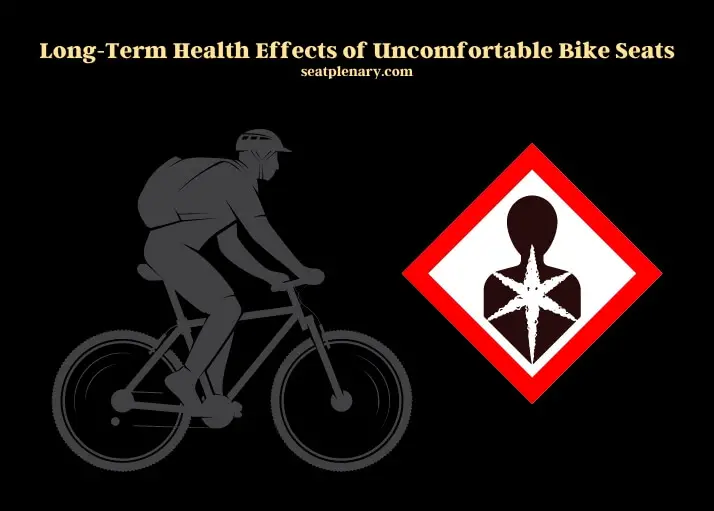Bike seats are often uncomfortable due to their design focusing on reducing weight and increasing efficiency rather than prioritizing rider comfort. The narrow shape and minimal padding can lead to pressure points and discomfort.
The discomfort experienced from bike seats stems from a combination of factors including the materials used, the width of the seat, and the distribution of the rider’s weight. Seats made from hard materials offer less cushioning, which can be unforgiving over long distances or rough terrain.
A seat that is too narrow fails to adequately support the sit bones, leading to increased pressure on soft tissues. This issue is compounded for riders with wider sit bones who may find standard seats particularly uncomfortable.

The way a rider’s weight is distributed on the seat plays a significant role in comfort levels. Incorrect weight distribution can cause undue pressure on certain areas, exacerbating discomfort. Adjustments to the seat’s position, such as height, angle, and fore-aft placement, can significantly impact comfort by ensuring a more natural and supported riding posture.
Properly fitted cycling attire, especially padded shorts, can also mitigate some of the discomfort by providing an additional layer of cushioning between the rider and the seat. Ultimately, achieving a comfortable ride requires attention to seat design, personal fit, and appropriate gear.
Bike Seat Design Flaws
Bike seats, often designed with performance rather than comfort in mind, can lead to significant discomfort for riders. The primary factors contributing to this discomfort include the stiffness of the seat, its narrow shape, and the minimal padding provided. These design choices are intended to reduce weight and increase efficiency for competitive cycling but do not favor the casual rider’s comfort.
The materials used, such as hard plastics or minimal foam padding, fail to adequately cushion the rider, leading to pressure points and discomfort during and after rides. This discomfort can be exacerbated by the seat’s shape, which may not align well with the anatomical variances in riders’ sit bone widths.
The narrow design, while aerodynamic, does not support the sit bones effectively for many riders, especially over longer distances. This lack of support and cushioning can lead to numbness, pain, and even long-term health issues with regular use. Adjustments to the seat’s angle and position can offer some relief, but the fundamental design issues often remain unaddressed, leaving riders searching for aftermarket solutions to improve comfort.
Style and Posture: Their Impact on Comfort
Riding style and posture play critical roles in the experience of bike seat comfort. Cyclists engaging in different types of riding—be it racing, commuting, or leisure—face varying degrees of discomfort based on how their posture interacts with the bike seat. Racing positions, which favor a forward lean, place significant pressure on the softer tissues rather than distributing weight across the sit bones. This can lead to discomfort and even health issues over time.
For commuters and leisure riders, a more upright posture might not alleviate discomfort if the seat does not accommodate their sit bone width or if the seat’s padding is insufficient. The interaction between rider posture and seat design highlights the need for a seat that can adapt to various riding styles and postures to prevent discomfort and potential health risks.
Innovations in Comfort: Technological Advances
Recent years have seen significant advancements in bike seat technology, with manufacturers introducing features like gel inserts, cut-out seats, and adjustable flexibility to enhance comfort. These innovations aim to address the core issues of pressure points, inadequate support, and lack of cushioning that contribute to seat discomfort.
Gel inserts, for example, offer a softer, more adaptable surface that can reduce pressure points. Cut-out seats alleviate pressure on sensitive areas by providing a void where pressure is most likely to accumulate.
Adjustable flexibility allows riders to customize the seat’s firmness to their preference, potentially improving comfort. Despite these advancements, finding the right combination of features that suits an individual’s unique anatomy and riding style remains a challenge. The effectiveness of these technologies varies widely among riders, underscoring the importance of personal fit and adjustment.
Personal Fit and Adjustment: Keys to Alleviating Discomfort
Proper bike fitting and seat adjustment are crucial for mitigating discomfort. Adjusting the seat height, angle, and horizontal position can significantly impact comfort levels, as these adjustments ensure that the rider’s weight is distributed correctly across the seat. A seat that is too high or too low can alter riding posture in ways that increase discomfort, while the correct angle and position can help distribute pressure more evenly.
Regular checks and adjustments are necessary to maintain optimal comfort, especially as the rider’s body adapts to cycling or as the seat materials settle and change shape over time. Personal fit extends beyond simple adjustments; it involves selecting a seat that matches the rider’s sit bone width and cushioning preferences, further highlighting the need for a personalized approach to bike seat selection.
Long-Term Health Effects of Uncomfortable Bike Seats
The prolonged use of uncomfortable bike seats can lead to a range of health issues, including chronic pain, circulation problems, and nerve compression. These issues arise from continuous pressure on soft tissues and inadequate support for the sit bones, leading to reduced blood flow and potential nerve damage. The health implications underscore the importance of addressing bike seat discomfort not only for immediate comfort but also for long-term health and well-being.

Riders experiencing discomfort should consider the potential health risks and explore options for improving seat comfort, including using seats designed with better support and cushioning, adjusting their bike fit, or consulting with a professional for personalized advice.
FAQs
Does Seat Material Affect Comfort?
The material of a bike seat plays a significant role in overall comfort. Seats made from hard materials, such as carbon fiber, offer high performance and durability but often lack the cushioning needed for a comfortable ride. On the other hand, seats with gel or foam padding can provide a softer, more forgiving surface, reducing the impact on the sit bones and soft tissues.
These softer materials may not offer the same level of support and can lead to discomfort on longer rides due to increased pressure on soft tissue areas. Finding the right balance between support and cushioning is key to enhancing seat comfort.
Can Weight Distribution Influence Seat Comfort?
Weight distribution significantly influences the comfort of a bike seat. An uneven distribution of weight can lead to increased pressure on certain areas of the seat, causing discomfort and pain. Ideally, a bike seat should support a rider’s weight evenly across the sit bones, minimizing pressure points and reducing the risk of discomfort.
Adjusting the seat position, height, and angle can help achieve a more balanced weight distribution, improving comfort for riders of all sizes and shapes.
How Does Seat Width Impact Comfort?
Seat width is crucial for ensuring comfort while cycling. A seat that is too narrow may not adequately support the sit bones, leading to increased pressure and discomfort. Conversely, a seat that is too wide can cause chafing and discomfort on the inner thighs, especially during longer rides. The ideal seat width varies from rider to rider, depending on the distance between their sit bones. A proper bike fitting can help determine the optimal seat width for each individual, enhancing comfort and reducing the risk of discomfort.
Is Rider Flexibility a Factor in Seat Comfort?
Rider flexibility can affect how comfortable a bike seat feels. Cyclists with limited flexibility may find it challenging to maintain a comfortable position on a seat designed for a more aggressive riding posture. This can lead to increased pressure on the hands, arms, and shoulders, as well as discomfort in the seat area. Seats with a more upright position can offer greater comfort for riders with limited flexibility, allowing for a more natural sitting position that reduces strain on the body.
Do Clothing Choices Impact Bike Seat Comfort?
The clothing a rider wears can have a significant impact on seat comfort. Padded cycling shorts, for example, provide an additional layer of cushioning, reducing pressure and friction between the rider and the seat.
These shorts are designed to wick away moisture, keeping the rider dry and comfortable during long rides. On the other hand, wearing non-cycling specific clothing, such as jeans or loose shorts, can increase friction and moisture, leading to discomfort and potential skin irritation.
How Important Is Seat Positioning for Comfort?
The positioning of a bike seat—its height, angle, and fore-aft placement—is critical for comfort. An incorrectly positioned seat can lead to improper leg extension, causing knee pain and reducing pedaling efficiency. The angle of the seat can also affect comfort; a seat tilted too far forward or backward can increase pressure on the hands or the soft tissues, respectively.
Proper seat positioning ensures that weight is evenly distributed, reducing pressure points and enhancing overall comfort. Regular adjustments may be necessary to find the optimal seat position for each rider, especially as riding styles and preferences change.
Summary
Bike seat discomfort stems from a variety of factors, including design flaws, riding style and posture, and the lack of personalized fit. Technological advancements offer solutions, but the key to alleviating discomfort lies in understanding and addressing the unique needs of each rider.
Proper seat selection and bike adjustment play critical roles in enhancing comfort and preventing long-term health issues. Riders are encouraged to prioritize comfort and fit when selecting a bike seat, ensuring a healthier and more enjoyable riding experience.
